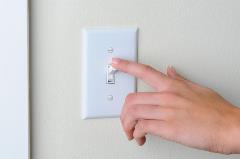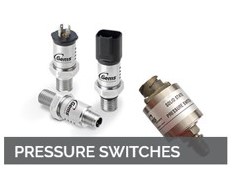How does a pressure sensor work?
Inside a pressure sensor, there is an element or diaphragm that, when pushed on by fluid or gases, responds electrically. This converts a mechanical change to an electrical change. The electrical response can be a change in output resistance, change of voltage, or change in current.

Why are pressure sensors used?
Pressure sensors monitor a process or system and send feedback to a controller. For example, if your process relies on a pump to keep it moving smoothly, a pressure sensor can monitor the actual pressure inside your system. If the pressure sensor detects that the system pressure is too low, it can send a signal to the pump and instruct it to speed up hence creating more pressure and keeping the machine running smoothly.

What are examples of pressure sensors?
Pressure sensors are broken down into two groups:
- Pressure Switches: On/off or digital output
- Pressure Transducers or Pressure Transmitters or Pressure Sensors: continuous or analog output
Pressure switches are simple on/off devices. Much like the light switch on the wall in your home. The electrical contacts are either open (and prevent current flow) or they are closed and allow the current to flow. As pressure rises and exceeds the pre-determined set point, the pressure switch will change state. If the contacts were open, they will close. If the contacts were closed, they will open.


Pressure Transducers / Pressure Transmitters / Pressure Sensors have a constant varying type of output, much like the light dimmer control in your home. As the sensor detects the pressure rising in your system, it will convert that pressure to a varying voltage or current output. This output can be sent to a controller or pump or display.


What type of sensor is pressure sensors?
There are three types of pressure sensors:
- Gauge pressure sensors:
- Utilize a breathing hole in the back of the sensor to allow the relative ambient pressure to not affect the output.
- If a gauge pressure sensor’s pressure port is open to the atmosphere (the air we breathe) and the barometric pressure changes, the sensor will not detect it. The change in pressure is seen on both sides of the sensor’s diaphragm and it negates the change.
- Sealed gauge pressure sensors:
- Are gauge pressure sensors but do not have a breathing hole in the back of them.
- Typically used when the measuring pressure range is at 1500 psi (100 bar) or above. With that, atmospheric pressure changes will have very little effect.
- Absolute pressure sensors:
- The back end of the sensor is sealed, and the chamber is evacuated from any air.
In this setup, if the sensor’s pressure port is open to the atmosphere, any changes in the atmospheric pressure will be measured by the sensor.
Learn More About Pressure Products:

Pressure Regulator, Solid State - 3100 Series Pressure Sensor
Traditional pressure regulators use a combination of internal nozzles
and springs to regulate how much pressure an application will be exposed
to down the service line. As the operator turns the mechanical
adjusting knob, a certain amount of pressure is allowed to pass thru the
regulator. If less pressure is required, the knob is adjusted again,
and less pressure is allowed thru.
Breathing Apparatus (SCBA) - 3100 Series Pressure Sensor
Human safety is the number one priority when working in oil fields or in
underground mines. Providing fresh air to the workers in these
environments relies on several critical systems working correctly to
ensure no harm comes to the workers. The worker will put on a
SCBA (or Self-Contained Breathing Apparatus) device over their face and
mouth.
 SEARCH OUR RESOURCE CENTER
SEARCH OUR RESOURCE CENTER




